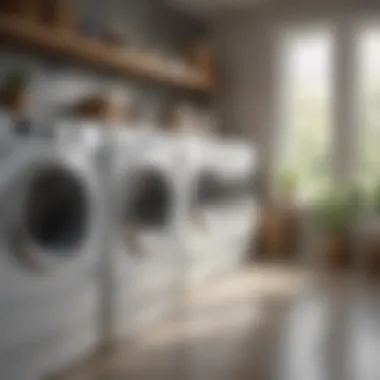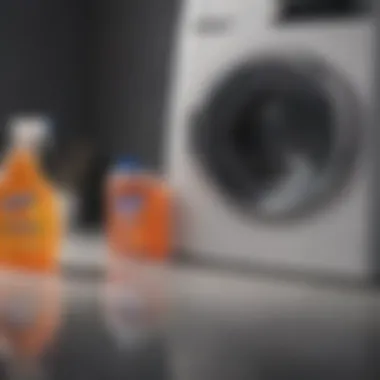Best Laundry Sanitizer: An In-Depth Analysis


Intro
In today’s world, cleanliness is not just a preference; it is a necessity. Among the many facets of maintaining a clean home, laundry sanitization plays a critical role. Understanding how to effectively use laundry sanitizers is essential for homeowners and renters alike. This article delves into what makes a laundry sanitizer effective, how to use it properly, the safety of various products, and the growing importance of environmentally friendly options.
Through thorough analysis, we aim to equip you with actionable insights to elevate your laundry hygiene practices. It is about knowing more than just the function of these products; it is about choosing the right one to align with your lifestyle and values.
Why Laundry Sanitizers Matter
Laundry sanitizers are formulated to attack harmful microorganisms that can linger on your textiles. This is especially relevant for items that come into contact with your skin, like bed sheets, undergarments, and towels. A poor laundry routine can allow bacteria, viruses, and allergens to thrive, posing serious health risks. Thus, incorporating a laundry sanitizer can significantly reduce the presence of these harmful agents.
Key Benefits of Laundry Sanitizers
- Enhanced Hygiene: They kill 99.9% of germs and bacteria.
- Odor Control: Effective in combating unpleasant odors, leaving fabrics smelling clean.
- Allergy Relief: Helps to minimize allergens that could trigger reactions.
For those who prioritize their family's health, it becomes abundantly clear why investing in an effective laundry sanitizer is vital. It goes beyond mere cleanliness, reaching into the realm of health and wellness.
"Understanding which laundry sanitizer suits your needs is crucial for achieving the desired level of cleanliness and hygiene."
Understanding Effectiveness
Effectiveness varies among products. Some sanitizers are designed for use in conjunction with regular detergent, while others can replace it entirely. It is crucial to read labels to understand the specific purpose of each product.
Types of Laundry Sanitizers
- Liquid Sanitizers: Ideal for soaking or adding directly to the wash cycle.
- Powdered Formulas: Often more concentrated and useful for heavy-duty cleaning.
- Sprays and Wipes: Convenient for quick surface sanitization, though not suitable for washing full loads.
With the growing market of laundry sanitizers, discerning which product aligns with your needs can feel overwhelming. It is essential to take into account the intended purpose, whether it is heavy-duty disinfecting or casual freshness.
Safety and Usage Considerations
Safety is paramount, especially when using chemical sanitizers in our domestic environment. Always consider the ingredients and follow usage instructions carefully.
Safety Tips
- Follow Dosage Instructions: Overuse can lead to residues on fabrics.
- Test Fabrics: Check colorfastness in an inconspicuous area first.
- Rinse Thoroughly: Ensures that any remaining product does not irritate sensitive skin.
Understanding safety measures allows for confident and effective usage, making the washing experience worry-free.
Environmental Considerations
With a growing awareness of our environmental impact, eco-friendly laundry sanitizers are gaining popularity. It’s not just about clean clothes; it’s also about maintaining ecological balance.
Features of Eco-Friendly Sanitizers
- Biodegradable Ingredients: Decomposes naturally, reducing landfill waste.
- Non-Toxic Formulas: Safer for children and pets.
- Concentrated Versions: Use less water and packaging while delivering results.
Choosing products that are gentle on the planet does not mean sacrificing effectiveness. As consumers, we bear the responsibility to choose wisely.
End
The journey into understanding laundry sanitizers involves recognizing the balance between hygiene, safety, and environmental impact. By equipping oneself with knowledge and making informed choices, homeowners can elevate their laundry practices significantly. Whether you are a busy professional or managing a household, a trusted laundry sanitizer is an ally worth researching.
Understanding Laundry Sanitizers
Laundry sanitizers have emerged as a crucial component in modern household cleaning practices. In an era where hygiene and cleanliness are paramount, understanding their role becomes essential for anyone responsible for maintaining textiles at home. This section examines the definition and purpose of laundry sanitizers, whilst also identifying common contaminants found in laundry that necessitate their use.
Definition and Purpose
Laundry sanitizers are specialized cleaning agents designed to kill harmful bacteria, viruses, and fungi on fabrics during the washing process. Unlike traditional detergents that primarily focus on removing stains and dirt, sanitizers target microorganisms that may reside on textiles, particularly in items that come into contact with skin, such as bed linens, towels, and clothing. Their use is particularly relevant in households with children, elderly family members, or individuals with weakened immune systems, as these groups are more susceptible to infections. Thus, these products contribute significantly to enhancing the overall hygiene level of your home.
In essence, the purpose of laundry sanitizers extends beyond just cleaning. They provide a protective barrier against invisible threats that can compromise health. With increased awareness of germs, the use of sanitizers in laundry practices is becoming more prevalent. Their importance cannot be overstated, as they play a vital role in ensuring that textiles are not only visually clean but also safe for everyday use.
Common Contaminants in Laundry
There are several types of contaminants that often linger in laundry. Understanding them helps to appreciate the necessity of using a laundry sanitizer. Common contaminants include:
- Bacteria: Staphylococcus aureus, E. coli, and other bacteria can thrive on fabrics, particularly in moist environments.
- Viruses: Cold and flu viruses can survive on clothing, especially when someone in the household is sick.
- Mold and mildew: These fungi can grow in damp laundry if left in the washer or laundry basket for too long.
- Allergens: Dust mites, pet dander, and pollen can settle on fabrics, causing allergic reactions.
"Sanitizers are not just an addition to your laundry routine, but an essential part of keeping your household safe from harmful microorganisms."
Recognizing these contaminants emphasizes why linen cleansing goes beyond the aesthetic. Using a laundry sanitizer addresses these issues directly, providing peace of mind and ensuring a healthier home environment. Understanding the role of these products enhances one's ability to make informed decisions about home hygiene practices.


Key Benefits of Using Laundry Sanitizers
Laundry sanitizers serve essential roles beyond basic cleaning. Understanding the key benefits can transform laundry routines into effective practices that enhance hygiene and maintain fabric quality. This section explores significant advantages such as eliminating harmful microbes, removing unpleasant odors, and prolonging the lifespan of textiles.
Elimination of Bacteria and Viruses
One of the most compelling reasons to use laundry sanitizers is their ability to eliminate bacteria and viruses. Traditional detergents may not always remove pathogens effectively. Laundry sanitizers include powerful active ingredients specifically designed to target and neutralize harmful microorganisms.
Recent studies indicate that laundry sanitizers can reduce the presence of common pathogens, including E. coli and Staphylococcus aureus, by significant margins. These microorganisms can thrive on fabrics, potentially causing illness or skin irritations. By incorporating a sanitizer into your wash, you ensure a higher level of cleanliness that standard cleaning agents alone may not achieve.
Odor Removal
Unpleasant odors can make fresh laundry feel unclean. Fabrics, especially those exposed to sweat, smoke, or food odors, can retain smells even after the wash. Laundry sanitizers address this issue by neutralizing odorous compounds rather than merely masking them.
The effectiveness of these products often lies in their formulation. Many sanitizers contain enzymes and surfactants that break down odor-causing substances, ensuring that your laundry not only looks clean but also smells fresh. Users can expect notable differences in freshness, making their home environment more pleasant and inviting.
Enhanced Lifespan of Fabrics
Long-term investment in home textiles cannot be overlooked. Over time, traditional washing methods can cause wear and tear on fabrics due to harsh chemicals and ineffective cleaning. Using laundry sanitizers can actually contribute to the longevity of various fabrics.
By effectively removing residues and preventing microbial buildup, sanitizers help maintain the integrity of fibers. It minimizes discoloration and degradation, especially in delicate items. Many users find that their garments remain vibrant and resilient longer when they include a sanitizer in their wash routine.
Types of Laundry Sanitizers
Understanding the different types of laundry sanitizers is crucial for homeowners looking to elevate their laundry practices. Each type offers distinct advantages and applications that can fine-tune the cleaning process and ensure optimal hygiene. Knowing these differences allows consumers to make informed decisions that align with their needs and preferences.
Liquid Laundry Sanitizers
Liquid laundry sanitizers are among the most popular types. Their form allows for easy mixing with water, ensuring an even distribution in the wash cycle. These products are often effective in targeting both stains and contaminants.
One of the significant advantages of liquid sanitizers is their versatility. They can be used in all types of washing machines, including high-efficiency models. Additionally, liquid products often have a rapid action time, meaning they start working quickly upon contact with water. This beneficial feature can be critical for those who frequently wash items with high germ exposure.
When choosing a liquid sanitizer, it is essential to evaluate the ingredient list. Some products include bleach or other strong chemicals, which may not be suitable for all fabrics. Opting for chlorine-free options is advisable for delicate textiles.
Powdered Sanitizers
Powdered sanitizers present another effective alternative, often favored for their long shelf life and concentrated formulas. This format can be particularly cost-effective for larger households. When dissolved in water, they can provide a powerful cleansing action, effectively reducing bacteria and viruses in fabrics.
The effectiveness of powdered sanitizers can vary depending on the temperature of the wash water. Generally, they perform best in warm or hot water. It is also important to follow the dosage instructions carefully, as using too much may lead to residue on clothes, which can be inconvenient.
Additionally, powdered products tend to have fewer preservatives, making them appealing for consumers seeking to minimize chemical exposure. However, always check for compatibility with your washing machine to avoid clogs or performance issues.
Sanitizing Pods
Sanitizing pods are a modern solution, offering convenience and precision. These pre-measured packets eliminate guesswork in dosage, ensuring consistent use. They also appeal to consumers who prefer a no-mess option.
Pods typically contain a blend of cleaning agents and sanitizers that activate once immersed in water. Their compact form makes storage easy, and they can be used in any washing machine. However, it is vital to keep these products out of reach of children due to their appealing appearance.
One concern with pods is their reliance on film packaging, which can sometimes fail to dissolve completely, especially in cold water. To enhance effectiveness, it's often advisable to use warm water for washes involving pods as the primary sanitizer.
In summary, each type of laundry sanitizer brings unique benefits. Liquid sanitizers offer versatility, powdered options provide concentrated power, and pods deliver convenience. Evaluating these factors according to your laundry needs will aid in selecting the most appropriate sanitizer.
Effectiveness of Laundry Sanitizers
The role of laundry sanitizers in ensuring hygiene cannot be undermined. Textiles, often carrying a multitude of germs, require effective cleaning solutions. Laundry sanitizers offer a tailored approach to target common pathogens, maintaining both cleanliness and safety for household members. The effectiveness of these sanitizers not only enhances the quality of laundry but also contributes to overall health, especially in households with vulnerable individuals.
Testing and Standards
The effectiveness of laundry sanitizers is contingent upon rigorous testing and adherence to established standards. Most sanitizers undergo testing by third-party organizations, which measure their ability to eliminate bacteria, viruses, and other pathogens. The benchmarks often include methods from the Association of Official Agricultural Chemists (AOAC) and the American Society for Testing and Materials (ASTM).
Key performance indicators include:
- Log reduction: Demonstrates the percentage decrease in microbial count.
- Contact time: Specifies the time the product needs to be in contact with contaminants for effective sanitization.
- Concentration: Indicates the necessary amount of sanitizer for proper efficacy.
Testing ensures that products meet safety and health claims, providing consumers with confidence in the products they choose. Understanding the standards to which these products are held is crucial for making informed decisions.
Comparative Analysis of Brands
When exploring effective laundry sanitizers, a comparative analysis of leading brands can offer insight into performance differences. Products such as Lysol Laundry Sanitizer, Purell Laundry Sanitizer, and Clorox Laundry Sanitizer each have unique attributes worth considering.
Factors to examine include:


- Ingredients: Different brands may leverage varying chemical compositions. For example, Lysol is known for its active ingredients that effectively kill 99.9% of viruses and bacteria. In contrast, Clorox focuses on bleach-based formulations that offer powerful disinfecting properties.
- User experience: Reviews from consumers provide real-world insights about effectiveness and ease of use. For instance, some users might prefer the convenience of Purell’s sanitizer pods, while others find the liquid format of Lysol more effective for their loads.
- Value for money: Price comparison against performance is essential. Higher price points do not always equate to superior effectiveness. Assessing the cost per load can aid in determining the best bang for your buck.
This comparative analysis facilitates educated decisions about which sanitizer aligns best with individual laundry needs, ensuring not only cleanliness but also health benefits for your family.
Choosing the Best Laundry Sanitizer
Selecting the right laundry sanitizer is crucial for maintaining a clean and hygienic household. The right product enhances the effectiveness of your laundry routine, ensuring that textiles are not only clean but also free from harmful microorganisms. Understanding what to look for when choosing a sanitizer can significantly impact both the quality of your laundry and your overall satisfaction with the product.
Evaluating Ingredients
When evaluating laundry sanitizers, it is essential to closely examine the ingredients listed on the product label. Not all sanitizers are created equal; some contain powerful agents that target a wide range of pathogens, while others may rely on less effective components. Key ingredients to consider include:
- Quaternary Ammonium Compounds: Typically effective against bacteria, but focus on sanitizers with established efficacy ratings.
- Hydrogen Peroxide: Known for its disinfecting properties. It breaks down into harmless water and oxygen, making it eco-friendly.
- Alcohol: Some sanitizers use isopropyl or ethanol to kill germs quickly and effectively.
- Chlorine Bleach: While effective, it can be harsh on fabrics and not suitable for all laundry.
Make sure to research any unfamiliar ingredients. Understanding these elements can help you make an informed choice that aligns with both your cleaning needs and personal safety concerns.
Certifications and Claims
Looking for recognized certifications can provide further confidence in the effectiveness of a laundry sanitizer. Certifications may include:
- EPA Registration: Indicates the product is tested and approved for safety and efficacy.
- NSF Certification: Often relevant for products designed to meet specific sanitation standards in food environments, indicating a higher cleaning standard.
- Allergen-Free Claims: If you or your family have sensitivities, these claims can be significant in choosing a safe option.
Always verify the claims made by manufacturers through independent reviews or scientific studies. Misleading claims can lead to poor product choices, so it is wise to be vigilant about what is promised on the label.
Price vs. Performance
Price is often a determining factor in product selection, but it is essential to balance cost with performance. A more expensive product does not always mean better quality. When assessing price versus performance, consider:
- Concentration: Higher concentration sanitizers might require less product per load, offering better value in the long run.
- Versatility: Some sanitizers can be used for multiple purposes beyond laundry, adding to their overall value.
- User Reviews: Gather insights from other users regarding both product effectiveness and longevity. This can help you gauge if the product provides solid performance relative to its price.
In summary, weighing these considerations will lead to a more informed decision regarding which laundry sanitizer serves your needs best. Choosing wisely not only impacts cleanliness but also helps manage safety and fabric care.
Environmental Considerations
When discussing laundry sanitizers, it is crucial to address their environmental impact. As consumers become more ecologically conscious, the demand for products that prioritize sustainability has risen. Choosing eco-friendly laundry sanitizers can significantly contribute to reducing pollution and conservatively interacting with our planet's resources.
Understanding the environmental aspects surrounding these sanitizers is essential. This section delves into biodegradable options and packaging sustainability, both of which play a significant role in selecting the right product for conscientious consumers.
Biodegradable Options
Biodegradable laundry sanitizers break down more easily in the environment, posing less harm to natural ecosystems. These products help mitigate soil and water pollution. Materials used in these sanitizers, which decompose naturally, have less chemical impact compared to their conventional counterparts. This aspect appeals especially to consumers who are aware of the persistent nature of many synthetic chemicals found in cleaning products.
Key Benefits of Biodegradable Options:
- Easier Decomposition: These products do not linger in the environment, making them a safer choice for water systems and wildlife.
- Reduced Toxicity: Many biodegradable sanitizers are formulated with fewer harmful chemicals, leading to a lesser chance of soil and water contamination.
- Sustainability Practices: Brands focusing on biodegradable options often embrace other sustainable practices, strengthening their commitment to ecological responsibility.
Packaging Sustainability
In addition to the product formulations, packaging also contributes to the environmental impact of laundry sanitizers. Sustainable packaging refers to materials that can be recycled or come from renewable resources. As a consumer, selecting products with minimal and responsibly sourced packaging can significantly affect waste management and resource conservation.
Considerations in Packaging Sustainability:
- Recyclable Materials: Opt for sanitizers packaged in bottles or containers that can be easily recycled, reducing landfill waste.
- Minimalist Packaging: Brands that use minimal packaging often reduce their carbon footprint, as they require less energy for production and distribution.
- Eco-Friendly Alternatives: Some sanitizers are packaged in biodegradable materials, adding another layer of environmental consideration.
In summary, packaging sustainability is as significant as the product itself. Consumers are encouraged to investigate brands that prioritize green packaging solutions. By doing so, they ensure their purchases align with a broader commitment to environmental preservation.
"The choices we make in our household cleaning products can influence the broader environmental landscape. An awareness of sustainability is vital for a better future."
In the end, integrating these elements into your purchasing decisions can make a difference in both maintaining personal hygiene and caring for the planet.
How to Use Laundry Sanitizers Effectively
Using laundry sanitizers appropriately is vital to maximize their effectiveness while ensuring fabric safety and maintaining hygiene. This section outlines essential methods for incorporating sanitizers into your laundry routine. Understanding how to use these products effectively improves cleanliness and extends the lifespan of your textiles.
Dosage Guidelines
Determining the right dosage of laundry sanitizer is crucial. Too much sanitizer can lead to residue buildup, while too little may do insufficient sanitization. Most brands provide clear dosage instructions on the label. Here are some general guidelines:
- Read the Instructions: Always refer to the manufacturer’s guidelines for the specific laundry sanitizer being used. Measurements can vary among products.
- Standard Dosage: Typically, 1/4 to 1/2 cup is adequate for a standard load, but larger loads may require more.
- Consider Hard Water: If you have hard water, you might need to adjust the dosage slightly. Hard water can affect how effectively the sanitizer works.
- Follow Soil Level: Heavily soiled items might benefit from an increased dosage, whereas light cleaning might require less.
Use a measuring cup specifically designed for laundry to ensure accuracy when adding the sanitizer to your wash. This practice minimizes errors and guarantees the desired effect.


When to Add Sanitizer
The timing for adding laundry sanitizer significantly affects its efficiency. Here are some best practices for the right moment to introduce sanitizer during the washing process:
- Before the Wash Cycle Begins: It is best to add laundry sanitizer to the empty drum before starting the wash cycle. This method allows for a more thorough distribution as the water fills.
- With Detergent: If your sanitizer is compatible with liquid detergents, you can mix them before adding to the wash. This ensures both products work together effectively.
- During the Rinse Cycle: Certain sanitizers are designed to be added during the rinse cycle. This method can enhance sanitization by ensuring that the fabric is exposed to the sanitizing agents longer.
Ensure that the water temperature aligns with the sanitizer requirements. Hot water often enhances the efficacy of most sanitizers.
Understanding these guidelines will lead to more effective use of laundry sanitizers, providing optimal hygiene while preserving your fabrics.
Potential Risks and Considerations
Understanding potential risks and considerations when using laundry sanitizers is critical. Even though these products are designed to enhance cleanliness and hygiene, their improper use can pose risks. There are specific elements to consider, particularly regarding chemical sensitivities and product interactions.
Chemical Sensitivities
Chemical sensitivities can manifest for many individuals after exposure to certain substances in laundry products. Many laundry sanitizers contain strong chemicals that can irritate the skin, cause respiratory issues, or lead to allergic reactions. It is important for users to read product labels carefully.
Some common symptoms that arise from these sensitivities include:
- Skin rashes
- Sneezing and coughing
- Difficulty breathing
For those who know they have sensitivities, selecting the right product is vital. Opting for fragrance-free or hypoallergenic sanitizers can help mitigate these effects. Always conduct a patch test before widespread use. A small amount applied to the skin will help identify any possible reaction before any larger quantity is used.
Laundry Product Interactions
Interactions between different laundry products can result in unforeseen consequences. Combining sanitizers with other cleaning agents may create harmful reactions. For example, mixing bleach-based sanitizers with vinegar or ammonia can produce toxic gases. It is essential to understand the composition of each product and follow manufacturer guidelines.
To avoid adverse reactions:
- Always read the instructions on each product.
- Do not mix different sanitizers unless explicitly stated as safe.
- If unsure, consult the manufacturer or a professional.
User Reviews and Experiences
User reviews play a critical role in the selection process for laundry sanitizers. They offer real-world insights that can significantly inform potential buyers. Reading about actual experiences can help users understand not only the strengths but also the limitations of a product. Some common themes in user feedback include effectiveness, ease of use, and scent. This information aids buyers in making informed choices based on preferences and needs.
Experiencing how a product works in various conditions allows users to weigh claims against actual performance. For busy households, insights into efficiency can influence purchasing decisions. Evaluating user reviews can lead to selecting a sanitizer that fits seamlessly into established laundry routines while also addressing specific concerns, such as allergies or environmental impact.
"A laundry sanitizer that works well can be a game-changer, especially for families with kids or pets."
Users often highlight essential aspects like value for money and accessibility. Such evaluations can guide consumers toward products that offer good performance without excessive costs. It’s worth noting, however, that individual experiences may vary based on laundry habits or the specific washing machine used. Thus, understanding the context behind reviews can help balance expectations.
Top-Rated Brands
When looking at top-rated laundry sanitizers, certain brands frequently emerge based on user reviews. Here are some of the most notable:
- Clorox: Known for its disinfecting capabilities, Clorox offers a laundry sanitizer that many users find effective against bacteria.
- Lysol: This brand is praised for its multi-use capabilities, including laundry, with a focus on eliminating viruses.
- OxiClean: Frequently recommended for its stain-fighting power alongside sanitizing benefits, it is a popular choice among households.
- Purell: While originally a hand sanitizer brand, it has made strides in the laundry segment with disinfecting solutions.
These brands regularly receive high ratings for their performance and user satisfaction. Notably, reviews often mention specific applications. For example, some products are favored for white laundry versus colored items. Thus, knowing the brand nuances can enhance selections.
Consumer Feedback Analysis
Analyzing consumer feedback presents a more nuanced view of laundry sanitizers. Feedback often includes detailed narratives about product experiences. Some users may discuss the effectiveness of sanitizers in removing odors or ensuring freshness.
Certain trends can be identified from consumer analysis:
- Effectiveness: Many reviews underscore the importance of meeting sanitization claims. Users want to know whether the product truly reduces germs and bacteria as advertised.
- Scent: For some, the fragrance of a laundry sanitizer is crucial. Reviews often note if the scent is overpowering or refreshing.
- Compatibility: Users also typically reflect on how well the product works with various fabrics. Some sanitizers may not perform as well with delicate clothing.
This feedback is invaluable in providing a comprehensive understanding of market preferences. By examining specific comments and summaries, prospective buyers can appreciate how different sanitizers fit unique needs.
In summary, user reviews provide critical insights into the effectiveness, scent, and compatibility of various laundry sanitizers. This information can guide selection, emphasizing the value of shared consumer experiences when assessing product performance.
The End
In the realm of homecare, the conclusion of any comprehensive analysis holds significant weight. It is the moment to reflect on the insights gained throughout the discussion and consider the practical implications of laundry sanitizers in daily life. Laundry sanitizers are not merely additional products; they are pivotal in promoting hygiene and extending the life of fabrics.
Summary of Insights
Throughout this article, we highlighted the necessity of sanitizing household textiles, examining the specific role of laundry sanitizers. The critical analysis covered various aspects, including their effectiveness in eliminating germs, odors, and enhancing fabric lifespan. We discussed the types available, effectiveness compared across brands, and the importance of understanding ingredients. Notably, we also considered environmental implications, emphasizing the rise of biodegradable options in the market. These factors illustrated that selecting the right sanitizer is integral to both personal health and environmental stewardship.
“The effectiveness of laundry sanitizers lies in their ability to reduce harmful contaminants, ensuring a superior level of cleanliness.”
Final Recommendations
As you contemplate the options available in the market, certain key recommendations emerge based on the analysis presented:
- Evaluate Ingredients Carefully: Prioritize products with transparent labeling and consider those that utilize eco-friendly compositions.
- Consider Certification Marks: Look for products that adhere to recognized safety standards. This can provide assurance about their efficacy and safety.
- Balance Price and Performance: While budget considerations are important, it is vital to remember that quality often corresponds with price. Invest in a product that promises effective sanitation.
- Test Different Formats: Different sanitizers work best in various washing conditions. Liquid, powdered, and pods all have unique advantages which may suit specific needs better.
By following these guidelines, homeowners can ensure they implement the best practices in their laundry habits. Understanding the role of laundry sanitizers, coupled with informed choices, promotes superior hygiene and care in household textiles.















